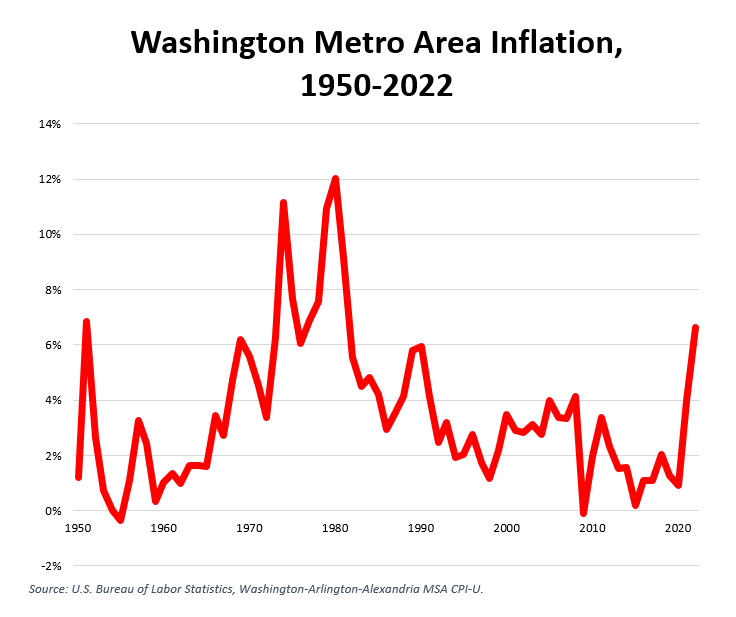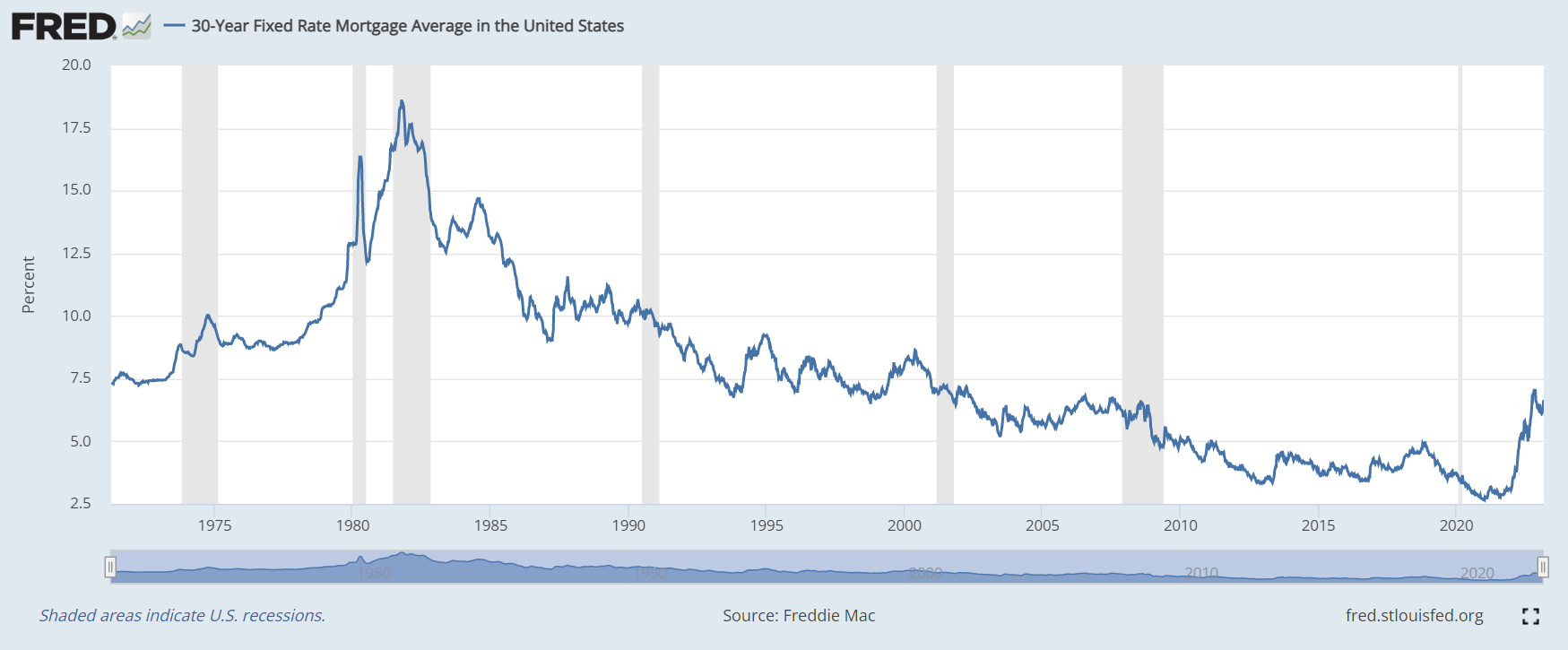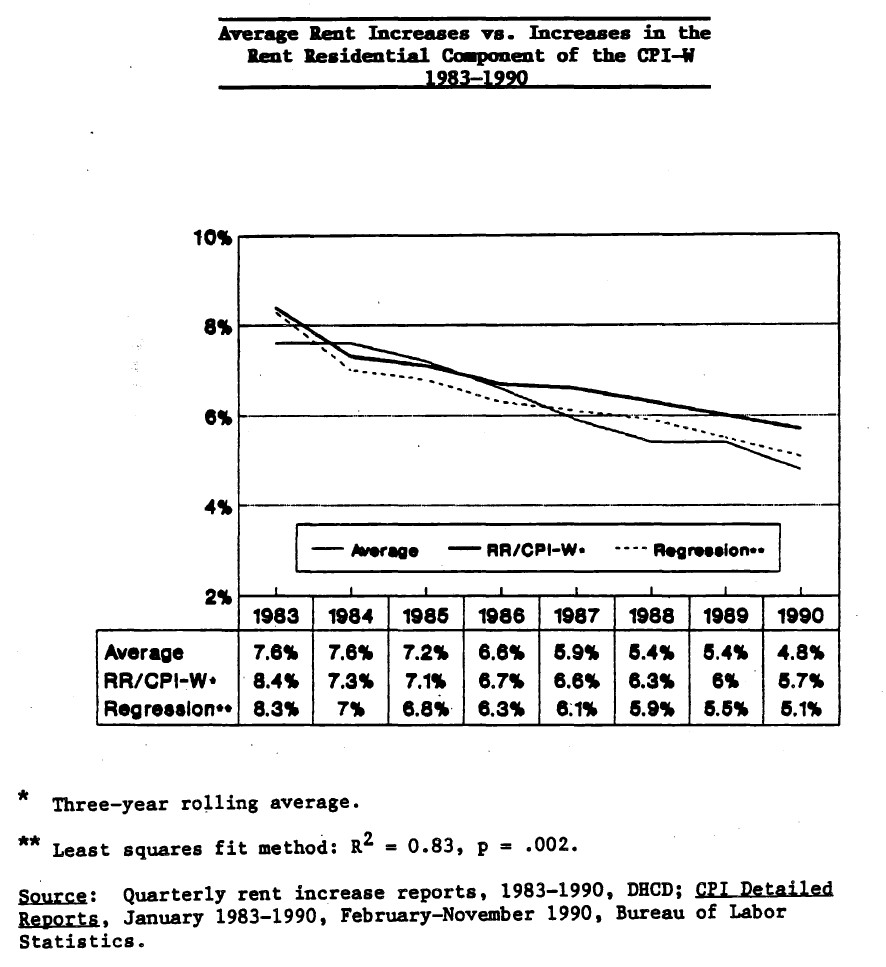By Adam Pagnucco.
As Montgomery County leaders debate the merits of installing rent control, it’s important to look back in time. That’s because the county had rent control in the 1970s. Why did the county install it and why was it repealed?
First, let’s understand the context of the time period. The 1970s was a turbulent decade with multiple recessions, trade disruptions and social and industrial change. Two related factors hit the real estate market. The first was inflation, which was tied to two international oil price shocks. Because energy is fundamental to the production of goods and services, prices spiked both internationally and locally. The chart below shows annual changes in the Washington-Arlington-Alexandria metro CPI-U since 1950. Note mounting increases throughout the 1970s with a spike of 12% in 1980.

The second important factor for real estate was mortgage rates, which increased during the 1970s and exceeded 18% by 1981. These rates were tied to price inflation and economic instability and rose partly due to an effort by the Federal Reserve to slow down demand and stop inflation once and for all. The chart below from Freddie Mac shows how historically unusual those mortgage rates were.

The combined effects of high inflation and high mortgage rates were challenging for the real estate industry. With both operating and financing costs spiking, landlords passed on those costs to tenants. Along with all other consumers, tenants cried out for help and the federal government imposed widespread price controls in the early 1970s. Rents were among those prices. When the feds began to roll back their controls in 1973, the Montgomery County Council adopted local rent control to replace them.
The history of county rent control is chronicled in a 1991 report by the county council’s Office of Legislative Oversight (OLO) as well as several surviving stories in the Washington Post. According to the OLO report:
Following the lifting of federal and state rent controls in January 1973, rent levels in the County began to increase rapidly, with some rent increases reportedly exceeding 40 percent. Compounding the problem of increasing rents was a shortage of affordable rental housing, evidenced by a rental vacancy rate of one percent.
The council reacted by freezing rents from February through October 1973 and then passing a series of rent control ordinances through the end of 1977. The report does not specify the increase formulas but does say that “Ceilings were established on the percent of rent increase that landlords could impose on different types of rental units in the County” and that landlords could apply for “extraordinary rent increases” with the county government. Some property types were exempted but they changed over time.
In December 1977, the council replaced rent control with a new ordinance that “repealed the County’s prior rent control statute, and replaced it with a program of rent reporting, voluntary rent guidelines, and tenant rights.” But that regime did not work well. The report states:
During 1978, many tenants in the County experienced large rent increases. OLTA [Office of Landlord and Tenant Affairs] records indicated that 36.6 percent of the reported rent increases were above the 6.1 percent rent guideline, with average rent increases ranging between 10 and 11 percent. To address what appeared to be a continuing emergency in the County’s rental market, the Council enacted Emergency Bill 18-79, which replaced the Omnibus Tenant Protection Act with a new article titled the “Rent Stabilization Act.”
The new law required landlords to get county government permission for any rent increases above 10% and was due to sunset in January 1981. Many landlords then threw in the towel on their properties, leading to the conversion of 6,000 rental units into condos between 1979 and 1981.
When the law was about to sunset, the council tried to renew it but County Executive Charles Gilchrist vetoed it. A 1981 Washington Post article details the reasons for the veto:
Gilchrist said in vetoing the bill that he does not believe decontrol will result in sharp rent increases, but would instead lead to more rental construction and fewer condominium conversions.
“I am convinced that our history of controlling rents in this county for nearly 10 years has contributed substantially to our condominium conversion boom,” Gilchrist said…
Gilchrist said rent control ran counter to efforts to encourage apartment construction. “The county government simply cannot approach landlords with incentive to remain in the rental housing business and at the same time maintain the rent control program,” he said.
The council could not override Gilchrist and rent control was dead. Voluntary rent guidelines survive to this day.
So did rent control kill housing production? According to a 1985 Washington Post article, Montgomery County saw 2,885 apartment unit permits from 1979 through 1981, when rent control was in effect. From 1982 through 1984, after rent control had expired, the county saw 3,857 apartment unit permits. But there is an important caveat to the earlier period:
Apartment construction also continued in Montgomery under rent control because developers financed their units through federal programs that would automatically exempt them from local controls. “By far the majority of those units were federally assisted in some way so rent control didn’t apply to them,” said Scott E. Reilly of the Metropolitan Washington Council of Governments.
The Post article also contained this quote from county housing director Richard Ferrara:
Montgomery County’s rent control program, like the one currently in place in the District of Columbia, also exempted nonsubsidized new construction. But developers argued that they believed that exemption alone was inadequate protection for their investments, because as long as rent control was in place, the locality could easily change its mind and subject new nonfederally subsidized construction to controls.
“Every developer that we talked to would say, ‘As long as we have rent control we don’t know what this crazy local government is going to do to us in two or three years,’” Ferrara said.
What happened to rents after rent control ended? According to OLO, rent increases actually went DOWN. The chart below shows how average rent increases fell from 1983 through 1990 in line with the rental component of the area’s CPI-W. In other words, as inflation receded, so did rent hikes.

The lesson of MoCo’s experience with rent control in the 1970s is this. Rent spikes were caused by market conditions of rising inflation and rising interest rates. Rent spikes were fixed by declining inflation, falling interest rates and rising home construction after rent control ended. Rent control exacerbated the county’s housing shortage by causing landlords to convert thousands of rental units into condos, which is why County Executive Gilchrist finally terminated it. This is a case study of how markets work then and now. Accordingly, policy makers must ask these questions:
Is it wise to enact permanent policy that risks creating a housing shortage in response to temporary market conditions? Or is it better to assist tenants and encourage home construction until the market returns to equilibrium?
